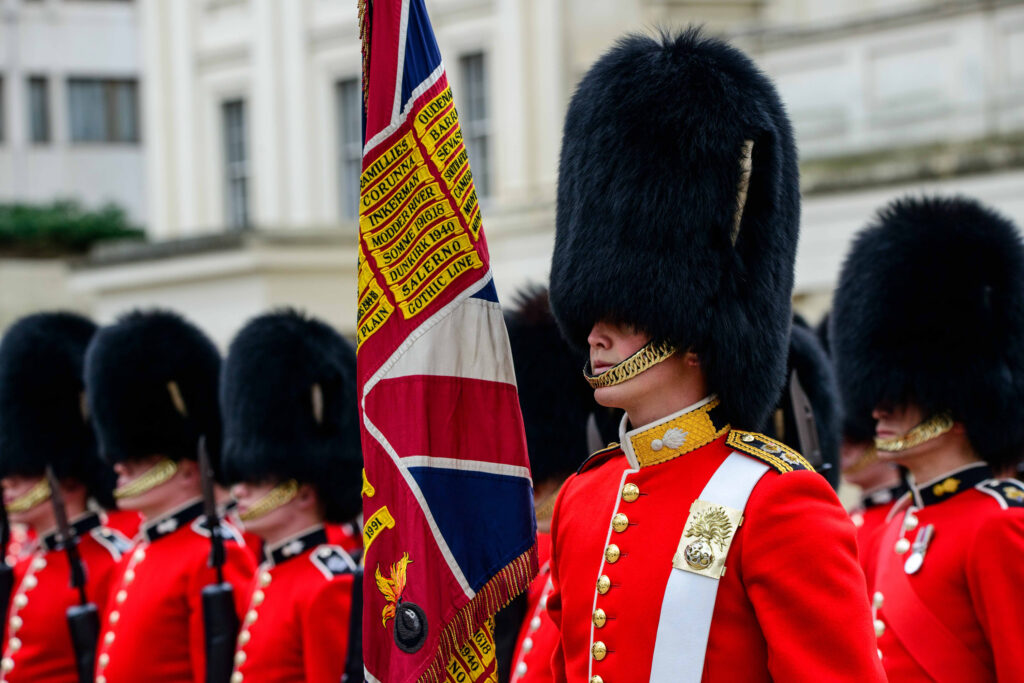
The Grenadier Guards are one of the oldest and most distinguished regiments in the British Army, renowned for their ceremonial duties, historical significance, and operational capabilities. Established in 1656, they hold a storied place within the Foot Guards, a division of the Household Division, and have served the British monarchy and nation with unwavering dedication.
Historical Background
The Grenadier Guards trace their origins to the New Model Army during the English Civil War, specifically to a regiment raised by Lord Wentworth in Bruges. They became part of the Royal Regiment of Guards under King Charles II, marking the beginning of their distinguished service. The name “Grenadier” was adopted in 1815 after the regiment’s significant role in defeating Napoleon’s Imperial Guard at the Battle of Waterloo. This victory led to the honor of wearing a bearskin headdress, previously exclusive to grenadier units, symbolizing their elite status.
Throughout their history, the Grenadier Guards have been involved in numerous key military engagements. From the wars of Spanish and Austrian succession to the Napoleonic Wars, the Crimean War, both World Wars, and recent conflicts in Iraq and Afghanistan, the regiment has consistently demonstrated exceptional bravery and professionalism.
Ceremonial Duties
The Grenadier Guards are perhaps most visible to the public through their ceremonial duties, which are a hallmark of British national identity. As one of the five regiments of Foot Guards, they play a crucial role in state and royal ceremonies, including the Changing of the Guard at Buckingham Palace, Trooping the Colour, and the State Opening of Parliament. These ceremonies are not merely symbolic; they embody the regiment’s historical connection to the British monarchy and its role as protectors of the sovereign.
Their ceremonial dress is iconic, featuring the red tunics and bearskin caps that are instantly recognizable worldwide. This uniform, along with their precise and disciplined drill movements, exemplifies the Grenadier Guards’ commitment to tradition and excellence.
Operational Role
While the Grenadier Guards are renowned for their ceremonial presence, they are also highly skilled operational soldiers. They serve as light role infantry, capable of rapid deployment and versatile in various combat environments. Their training prepares them for a wide range of military operations, from peacekeeping missions to frontline combat.
In recent decades, the Grenadier Guards have been deployed in numerous international missions, reflecting their adaptability and professionalism. They have served in Northern Ireland during the Troubles, participated in peacekeeping operations in Bosnia and Kosovo, and been involved in combat operations in Iraq and Afghanistan. These deployments demonstrate their ongoing commitment to global security and their ability to operate effectively in diverse and challenging conditions.
Training and Recruitment
The training regimen for the Grenadier Guards is rigorous, reflecting the high standards expected of its soldiers. Recruits undergo a demanding 30-week Combat Infantry Course at the Infantry Training Centre in Catterick, where they receive comprehensive instruction in infantry skills, weapons handling, physical fitness, and battlefield tactics. This training ensures that every guardsman is fully prepared for both ceremonial duties and operational deployments.
Recruitment into the Grenadier Guards is competitive, with an emphasis on selecting individuals who exhibit physical endurance, mental resilience, and a strong sense of duty. Historically, the regiment has attracted recruits from across the United Kingdom and the Commonwealth, fostering a diverse and inclusive environment.
Cultural Impact and Legacy
The Grenadier Guards have left a lasting cultural impact, symbolizing the valor and tradition of the British Army. Their presence at state events, such as royal weddings and state funerals, reinforces their role as key figures in the ceremonial life of the nation. The regiment’s music, particularly the Grenadiers’ March, has become an integral part of British military and cultural heritage.
Their legacy is also marked by notable members, including various members of the British royal family who have served with the regiment, underscoring its close ties to the monarchy. The Grenadier Guards’ motto, “Honi soit qui mal y pense” (Shame on him who thinks evil of it), reflects their ethos of honor and integrity.
Conclusion
The Grenadier Guards stand as a testament to the enduring traditions and evolving capabilities of the British Army. From their origins in the 17th century to their current roles, they embody a unique blend of historical significance, ceremonial grandeur, and operational excellence. Their commitment to serving the Crown and country ensures that they remain a vital part of Britain’s military and cultural landscape.